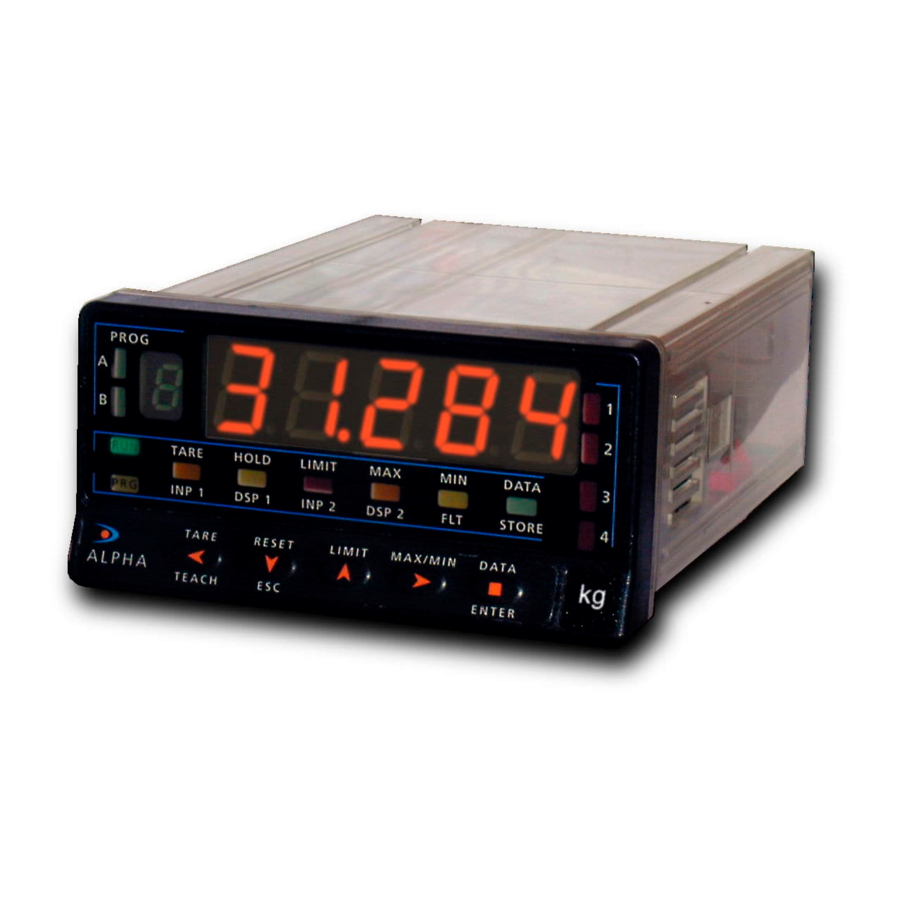
Ditel KOSMOS Series Quick Start Manual
Loop powered trip amplifier
Hide thumbs
Also See for KOSMOS Series:
- Instruction manual (56 pages) ,
- Manual (51 pages) ,
- User manual (31 pages)
Table of Contents
Advertisement
Quick Links
KOS1402
LOOP POWERED
TRIP AMPLIFIER
kos1402manualB.doc
30727053
WARRANTY
The instruments are warranted against defective materials and
workmanship for a period of three years from date of delivery.
If a product appears to have a defect or fails during the normal use
within the warranty period, please contact the distributor from which
you purchased the product.
This warranty does not apply to defects resulting from action of the
buyer such as mishandling or improper interfacing.
The liability under this warranty shall extend only to the repair of the
instrument. No responsability is assumed by the manufacturer for
any damage which may result from its use.
KOSMOS
SERIES
1.0 SPECIFICATION @20ºC
1.1 KOS1402 LOOP POWERED TRIP
Input
Type
Protection
Loop Drop
Output
Alarms
2x high/low alarms selected by switches (side entry)
Contact
Rating
Indication
Setpoint
0-100% multi turn trip set potentiometer,(access
on module front face). (Repeatability 0.2%)
Hysteresis
Delay
Failure mode
(ie Alarm operates as if signal has fallen to -25% or 0mA)
Minimum Current
1.2 GENERAL SPECIFICATIONS
Isolation
Ambient
Conection
Oct.99
Cable size
Case material
Case Flammability
Dimensions
Mounting
Max Vibration
Shock Res
Compliant with
Weight
2.0 INSTALLATION
Warning - Hazardous voltages may be present on the terminals - the
equipment must be installed by suitability qualified personnel and
mounted in an enclosure providing protection to at least IP20.
Warning - If not installed and used in accordance with these instructions,
protection against hazards may be impaired.
(IMPORTANT NOTE: it may be preferable to set the user adjustment on
the bench prior installation. Please read Section 2 before installation).
2.1 MECHANICAL
This trip must be housed within a suitable enclosure that will provide
protection from external enviroment, ensuring that the stated temperature
and humidity operating ranges are maintained. As KOS1402 contains high
quality relays, the usual precautions taken when using products containing
relays apply, such as care must be taken to ensure the trip is not
subjected to strong shock or vibration, as this may result in momentary
opening of the relay contacts. The KOS1402 must not be located near a
strong magnetic field, such as a transformer,solenoid or electric motor.
The KOS1402 case designed to snap fit onto a standard "TOP HAT" DIN
Rail. To remove from DIN rail, apply pressure at the bottom face at the
back upwards towards the rail to release the spring clip and tip away from
the top. The trip may be mounted in any orientation and stacked side by
side along the rail.
2 wires 4-20mA, 50mA Max
Reverse conection protected
5V MAX
2 x N.O. relay contacts with shared common
Resistive load 2A @ 250V AC/125V DC
Max Power 150W (Inductive Loads)
2 x Alarm LED on module front face
Fixed at 0.5%
0.5 second fixed delay
On loss of signal:
High level:
no alarm condition
Low level:
Alarm condition
3.5mA
3000VAC rms between contacts and input
1000VAC rms between contacts
0-50ºC; 10-95% RH non condensing
Captive clamp screws
4mm sq solid / 2.5mm sq stranded
Grey Polyamide
UL94-V0 VDE 0304 pt3 level IIIA
60x60x21mm
Rail DIN EN 50022-35
12G 10 to 55Hz at double amplitude 2mm
12G
EN50081-1, EN50082-1
60g
2.2 ELECTRICAL
Conections to the trip are made via screw terminals with wire protector
plates provided inside each terminal. To maintain CE compliance twisted
pair (screened) cables are recommended for signal connections. It is also
good practice to ensure that all 4-20mA loops are grounded at a single
point. Before installation ensure the 4-20mA loop has enough voltage
available to drive the trip. Refer to the above specification for the loop
voltage drop. The dual contacts provided by the KOS1402 are capable of
switching 250V AC 125V DC @ 2A resitive load, 150Watts inductive load.
Internal Varistors are connected across the contacts to protect against
over voltage. It is advised that a external R/C snubber network is used
when switching inductive AC loads, see fig 1. When switching DC
inductive loads, a diode connected in parallel with the inductor must be
used to protect the contacts from the energy stored in the inductor (See fig
2).
Advertisement
Table of Contents

Subscribe to Our Youtube Channel
Summary of Contents for Ditel KOSMOS Series
- Page 1 1.0 SPECIFICATION @20ºC 1.1 KOS1402 LOOP POWERED TRIP Input Type 2 wires 4-20mA, 50mA Max Protection Reverse conection protected Loop Drop 5V MAX KOS1402 Output Alarms 2x high/low alarms selected by switches (side entry) Contact 2 x N.O. relay contacts with shared common Rating Resistive load 2A @ 250V AC/125V DC Max Power 150W (Inductive Loads)
- Page 2 Fax : +34 - 93 490 31 45 which should be near the equipment. E-mail : dtl@ditel.es The equipment contains no user serviceable parts. www.ditel.es 3.0 ALARM SETUP Note: Latching relays are used in this product in conjunction with an advanced relay drive circuit.















Need help?
Do you have a question about the KOSMOS Series and is the answer not in the manual?
Questions and answers